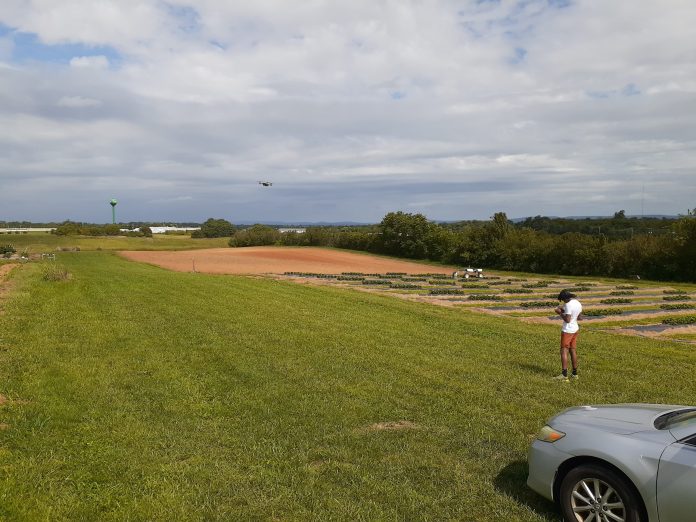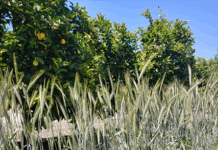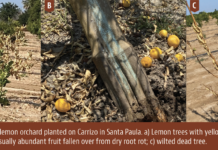
This article summarizes the recent work of a multi-disciplinary research team on strawberry disease and arthropod pest management using a robotic Ultraviolet-C (UV-C) irradiation machine. The team’s desire to develop novel approaches for more sustainable strawberry culture (e.g. non-chemical and safer use of ultraviolet light) was based on the following factors: Reliance on fungicides for management of diseases (e.g. development of resistance to more synthetic pesticides, phytotoxicity, environmental issues, application residues, etc.,) make chemical management of Botrytis gray mold of strawberry often challenging and costly, especially when the harvesting period exceeds six months; Pestiferous insects and mites are developing resistance to synthetic pesticides, increasing demands by consumers for pesticide-free berries; Need for automation to reduce labor input in the field; Need for systematic approaches for disease and pest management that are less intrusive to workers in the field, harvesting and myriads of seasonal cultural operations.
Sustainable Approach Through UV-C
The idea of using UV light to control fungal diseases of strawberry fruit came from a discussion between Drs. Janisiewicz and Takeda in 2010 about problems with use of fungicides and needs for alternative control methods. UV light includes electromagnetic radiation with wavelengths between 100 and 400 nanometers (nm), which is shorter than that of visible light but longer than X-rays. UV radiation is present in sunlight, but almost all the UV light produced by the sun is filtered out by the ozone in the upper atmosphere. UV light can also be produced by specialized lights such as mercury-vapor lamps and tanning lamps, LEDs and specific wavelength excimer lamps. UV radiation is subdivided into three general classes based on their wavelengths (i.e. UV-A ranges from 315 to 400 nm, UV-B ranges from 280 to 315 nm, and UV-C ranges from 100 to 280 nm.)
Research with UV-A and UV-B has shown that insect behavior could be altered by modulating UV irradiation levels. Research on UV-B showed that a nightly ~3-hour exposure time was necessary to achieve adequate control of diseases such as powdery mildew on grapes and strawberry. UV-C irradiation is used to kill microorganisms in different situations including sterilization of air in hospitals, water treatments, sterilizing laboratory benches and treatment of meat and poultry products. The FDA has determined that UV light can be used to surface sterilize food products, and considers UV light to be safe when precautions are taken by the user.
The use of UV light in crop production, however, has been limited because the doses required to kill plant pathogens usually can cause damage such as leaf burn and defoliation. The goal of the team’s research program has been to develop UV-C treatment methods that have high efficacy for disease and pest control without damaging plants and are cost effective.
What is known is that UV-C irradiation kills microorganisms and arthropod pests by damaging their DNA. What other agricultural researchers had not considered in their treatment protocol was the fact that microorganisms and mites have a special mechanism for repairing the damaged DNA. This occurs when light is present, e.g. the repair process is “light activated”. Thus, there is a simple question: What happens if the microbes are irradiated with UV-C at night and they are kept in the dark for certain periods of time? The reasoning for this approach was a) That the dark period following UV-C irradiation will prevent the activation of this DNA repair mechanism that needs sunlight to become active and b) Without the ability to repair the damage to DNA, the organism would not be able to replicate and further infect plant, eventually causing the microbes to die. The night application of UV-C light for control of pathogens and pests allowed the team to use much lower doses of UV-C light that was still effective and, more importantly, was below the threshold that causes damaging effects on the strawberry plant.
Robotic Application Methods for Pest and Disease
In the May/June 2018 issue of Progressive Crop Consultant, the team reported on the use of germicidal UV-C irradiation for the control of major fungal diseases of strawberries (e.g. gray mold, anthracnose and powdery mildew.) Currently, the team has prototype autonomous platforms applying UV-C light to in-soil strawberry plants at night. As the research on diseases progressed, the project expanded to include management of insects and mites and development of an autonomous vehicle to apply UV-C treatments. The team is aware that research on using UV-B and UV-C irradiation to control diseases and arthropod pests on various crops had been conducted for more than two decades in various laboratories around the world, including several in the U.S., the Netherlands, Belgium, Brazil, Canada, China, Japan, Norway and the United Kingdom. Their research consistently reported plant damage described as burns, leaf curls and defoliation after irradiating the plants with doses required to control diseases and arthropod pests. Recently, some of these laboratories have transitioned to using UV-C lamps in their research.

Our research approach has focused on new ways of using UV-C light to kill strawberry pathogens and arthropod pests (insects and mites) without damaging the strawberry plant. Initial studies clearly demonstrated that a dark period of 2 to 4 hours (depending on which pathogen was being controlled) immediately after a UV-C irradiation of one minute or less prevented microbes from repairing DNA damage (e.g. repair mechanism requires daylight) caused by UV-C irradiation and prevented the disease to develop on fruit and leaves. This method of UV-C irradiation at night resulted in lowering the effective doses needed to kill the microbes that cause strawberry gray mold, powdery mildew and anthracnose. The reduced doses required to kill plant pathogens caused no apparent damage to strawberry plants. Further analyses revealed there was no damage to chlorophyll, no reduction in photosynthetic activity, no loss in pollen viability (ability of pollen tube to grow through the style) and development of fruit, and no reduction in fruit phenolic content as determined by metabolomic analysis.
Another aspect of the team’s research program is to study other direct effects of UV-C light on plants. Since research was being conducted on diseases, the team asked, “Can UV-C light make the strawberry plant more resistant to fungal infection?”
It is known that when a plant is perturbed by abnormal environmental or biotic factors such as insect feeding, it responds by producing more phenolic and other chemical compounds such as jasmonic acid to make itself resist infection by a pathogen or an attack from insects and mites. For this test, the team harvested leaves from strawberry plants that had been treated with brief (15 to 60 second) nightly applications of UV-C irradiation for about a month and then inoculated each leaflet with two agar plugs with actively growing fungus-causing anthracnose (Colletotrichum). Over a period of 7 to 10 days, the team observed the infection (black and yellow lesion) develop on the leaves.

On the leaves taken from UV-C irradiated plants, the dark area was confined to the agar plug, while on the leaflets taken from untreated plants, the lesion radiated out from the plugs and caused large areas of the leaflet to turn black and yellow. The team’s research has shown that multiple levels of biological effects occur on disease-causing pathogens as well as make plants exposed to night-time UV-C light treatments more resistant to fungal infection.
The team also showed that night-time UV-C treatments were effective against insects and mites. A detailed study with plants artificially infested with ~100 two-spotted spider mites (TSSM) revealed that nightly 60-second UV-C irradiation of plants for six weeks had reduced mite populations to below a commercial treatment threshold of five mites per mid-canopy leaflet, while mite population on untreated strawberry plants exploded to over 300 mites per leaf. Tomato plants artificially infested with greenhouse whitefly (GWF) were irradiated for just 16 seconds nightly. The results showed a decline in adult, nymph and egg populations on UV-C treated plants within two weeks.
The team also conducted studies on spotted wing drosophila (SWD). In that study, store-bought strawberries were artificially infested with adult female SWD and then were subjected to a pulsed UV-C light treatment. Over time, 12 SWD on average emerged from each untreated control fruits compared to only 1 SWD among 40 UV-C treated fruits. A better way to use UV-C irradiation is to prevent fungal pathogens from infecting susceptible plants, pestiferous insects and mites from infesting the crops, and prevent egg laying in the fruit. The team has plans to refine the UV-C light regimen, quality and application technology to make the UV-C technology more practical for commercial berry producers. Currently, the team is exploring ways to use UV-C irradiation more effectively and to further reduce the time required to treat each plant so that the robot can travel over a larger area each day.
Things to Consider
Substantial costs can be incurred through application of synthetic pesticides, scouting or monitoring, especially if the annual crop is being harvested over six months. UV-C irradiation provides the opportunity to reduce chemical and labor inputs for management of T. urticae, gray mold, anthracnose, powdery mildew and pestiferous insects in the production of specialty crops. In the team’s research, the engineering aspects of the robot technology and optimizing the UV-C system to make the technology economically competitive with conventional chemical control approaches are being refined.
Further field-based validation is needed to confirm the efficacy of the system on a broader scale to compare with conventional management practices (e.g. pesticide application). Prototype autonomous mobile UV-C irradiation units that could traverse multiple strawberry rows have been developed and evaluated under field conditions. To date, the team has used strawberry plants and their fruit as a model system, but this UV-C technology may be widely applicable to other specialty crops.
Future Directions
Currently, the team is evaluating ways for reducing the duration and frequency of exposure, comparison of daytime and night-time applications and addressing the need for deeper penetration of UV-C light into the plant canopy. Mites prefer to colonize and
lay eggs on the undersides of leaves and in the lower portions of canopies. Therefore, UV-C penetration is critical. The team’s study has shown that UV-C ir radiation reaching the lowest portions of the strawberry plants was reduced by ∼45% compared to that received by the upper surface of leaves at the upper canopy. This reduction in intensity may have played a role in supporting the survivorship of mites recorded in the lower canopy. Japanese researchers have reported that reflective mulches enhance UV light penetration to the undersides of the leaves. Also, arthropod management with UV-C light should be examined in conjunction with our technology to increase management efficacy and bring pest populations below the economic threshold levels.
The positive results obtained from night-time application and relatively low doses of UV-C irradiation for controlling fungal pathogens and arthropod pests to date indicate the potential of UV-C treatments to reduce disease incidence and alter insect behavior impacting their herbivory and egg laying. The team will continue to explore the efficacy of the UV-C irradiation system for management of pestiferous mites and insects on other specialty crop plants. To make UV-C technology commercially useful for open-field strawberry growing systems and nurseries, a prototype robot for applying UV-C was developed and field-tested in 2019 and 2020. USDA is now collaborating with TRIC Robotics (tricrobotics.com), which has highly skilled robot engineers, manufacturing capacity, and provides on-the-go solutions for autonomous UV-C application for specialty crops. The robotic platform is agricultural equipment built to control pests and diseases. As such, UV-C application equipment will be certified by EPA as a pesticide device. The videos of their robot applying UV-C treatments in the field during night time and day time can be accessed on YouTube by searching the key words “TRIC Autonomous UV-C Treatment.”
Now, it is not so much a question of whether UV-C light treatments can be applied effectively to field-grown specialty crops, but how soon application equipment and UV-C technology will be available to large and small growers. The team is currently conducting R&D work to develop a commercially viable UV-C delivery system that is affordable, user friendly, generally compatible with current production practices, as effective in controlling diseases and pests as currently used pesticides and reduces the overall costs of disease and pest control practices.
It is important to develop a platform that is useful and affordable to small-acre strawberry growers. The Northeast has over 200 certified organic farms with five acres or less of strawberries. To fund this aspect of the UV-C research project, the team received a grant in 2020 from the USDA Northeast Sustainable Agriculture Research and Education (SARE) program to improve control of diseases and arthropod pests of strawberry. Also, the robotic UV-C application system is being developed for large-scale strawberry growers and nurseries in California and elsewhere. Cooperating growers in California have been identified to conduct large pilot studies that will begin in early 2021.
Summary
The management of disease-causing fungal pathogens and arthropod pests is a complex task for specialty crop producers, particularly given the occurrence of latent infection by Botrytis cinerea and the highly perishable nature of fruits and berries, and the need for a complete control of SWD in berry fields. This requires comprehensive knowledge of disease etiology, host-plant biology and the physical environment determining the severity of infection and pest infestation.
Failure to manage Botrytis cinerea at bloom will have an impact on subsequent stages of fruit development, especially when the fruit reaches harvest maturity. Future research will certainly focus on multi-pronged strategies instead of searching for a single “silver bullet” answer to produce effective, long-term solutions for specialty crop growers. These solutions will surely include genetic improvements, the integration of night-time UV-C applications for a range of cropping systems along with use of “clean” nursery plants, good sanitation practices, new chemicals, and knowing how environmental conditions affect the biology of pathogens and pests to reduce disease pressures and pest infestation.
Additional information on UV-C light technology can be requested from F. Takeda (fumi.takeda@usda.gov). Further discussion on the UV-C technology can be found in the additional resources section.
Additional Resources
Janisiewicz, W. J., Takeda, F., Glenn, D. M., Camp, M. J., and Jurick, W. M. II. 2016. Dark period following UV-C treatment enhances killing of Botrytis cinerea conidia and controls gray mold of strawberries. Phytopathology 106: 386-394. https://doi.org/10.1094/PHYTO-09-15-0240-R
Janisiewicz, W. J., Takeda, F., Jurick II, W. M., Nichols, B. and Glenn, S.M. 2016. Use of low-dose UV-C irradiation to control powdery mildew caused by Podosphaera aphanis on strawberry plants. Can. J. Plant Pathol. 38:430-439. https://www.tandfonline.com/doi/full/10.1080/07060661.2016.1263807
Takeda, F., Janisiewicz, W.J., Smith, B.J., Nichols, B. 2019. A new approach for strawberry disease control. Eur. J. Horticult. Sci. 84:3-13. https://www.pubhort.org/ejhs/84/1/1/index.htm
Short, B., W. Janisiewicz, F. Takeda, and L. Leskey. 20/18. UV-C irradiation as a management tool for Tetranychus urticae on strawberries. Pest Management Science 74(11):2419-2423. https://doi.org/10.1002/ps.5045
Sun, J., W. J. Janisiewicz, F. Takeda, B. Evans, W.M. Jurick, M. Zhang, L. Yue, and P. Chen. 2020. Effect of nighttime UV-C irradiation of strawberry plants on phenolic content of fruit: Targeted and non-targeted metabolomic analysis. J. Berry Res. 10(3):365-380. https://www.doi.org/10.3233/JBR-190482



















